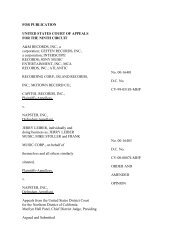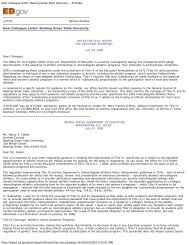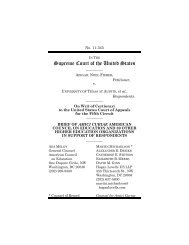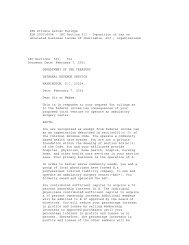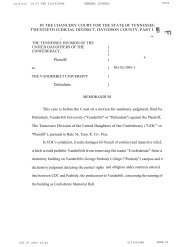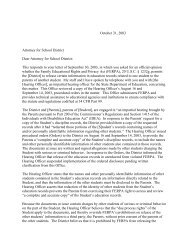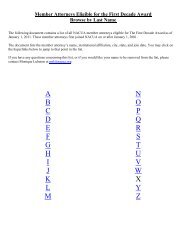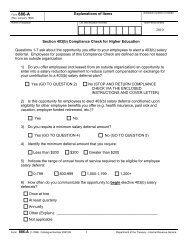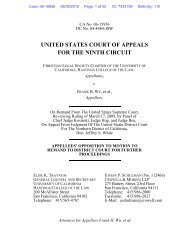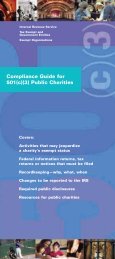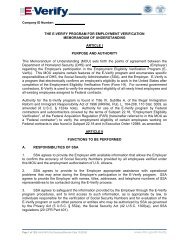Summy-Long v. Pennsylvania State University, et al. - National ...
Summy-Long v. Pennsylvania State University, et al. - National ...
Summy-Long v. Pennsylvania State University, et al. - National ...
- No tags were found...
Create successful ePaper yourself
Turn your PDF publications into a flip-book with our unique Google optimized e-Paper software.
Dean Kirch and Grigsby chose to hire an extern<strong>al</strong> consultant to conduct a more thorough studyrather than to compl<strong>et</strong>e the OHR study. (Id. 230-32; Doc. No. 91 2.) Dean Kirch andGrigsby did not disclose the preliminary findings of the OHR study to Plaintiff. (Doc. No. 91 2.)Haignere ReportOn July 11, 2001, Plaintiff and other WFG members wrote a l<strong>et</strong>ter to Dean Kirchrequesting that an outside consultant conduct a s<strong>al</strong>ary study “with speci<strong>al</strong> attention to genderbias.” (Doc. No. 43 218, 222.) The l<strong>et</strong>ter outlined the reasons WFG members felt that anextern<strong>al</strong> consultant was necessary, including their belief that “the problem of gender inequity hasnot been addressed satisfactorily” despite over ten years of Faculty Senate studies indicating agender bias in s<strong>al</strong>ary. (Id. 222-23.) The l<strong>et</strong>ter <strong>al</strong>so expressed that Plaintiff, and other WFGmembers, “have serious concerns regarding s<strong>al</strong>ary equity at the Penn <strong>State</strong> College of Medicineand Hershey Medic<strong>al</strong> Center.” (Id. 224.) Dean Kirch informed WFG members on August 22,2001, that the suggestion to hire an extern<strong>al</strong> consultant was being considered. (Id. 226.) InNovember of 2001, Plaintiff was informed that the <strong>University</strong> had decided to hire an independentconsultant to conduct a new s<strong>al</strong>ary study. (Id. 234.)In January of 2002, COM r<strong>et</strong>ained Haignere, Inc. (“Haignere”) to conduct an an<strong>al</strong>ysis offaculty s<strong>al</strong>aries to d<strong>et</strong>ermine wh<strong>et</strong>her s<strong>al</strong>ary disparities existed by gender or race. (Id. 235.) TheHaignere study considered s<strong>al</strong>aries in effect during the 2001-2002 academic year only. (Id. 244-45.) On October 14, 2003, Dr. Haignere presented the preliminary findings to WFG, DeanKirch, and Grigsby. (Id. 252.) She found that a class-based s<strong>al</strong>ary disparity with respect togender existed at COM. (Id. 255.) In response to Haignere’s preliminary findings, Dean Kirch-6-
stated that he accepted the truth of the findings, and that he intended to take corrective measuresin the form of class-based s<strong>al</strong>ary adjustments. (Id. 257-58.)On November 20, 2003, Plaintiff and other WFG members m<strong>et</strong> with Dean Kirch andGrigsby to discuss the administration’s plans to make s<strong>al</strong>ary adjustments. (Id. 262-64.) Duringthis me<strong>et</strong>ing, Dean Kirch stated that an across-the-board group adjustment would be made, butthat “there is no expectation of making r<strong>et</strong>roactive s<strong>al</strong>ary adjustments.” (Id. 266-68.)Haignere compl<strong>et</strong>ed the fin<strong>al</strong> report of COM s<strong>al</strong>ary equity in June of 2004. (Id. 273.)After seeing the report, Dean Kirch stated that class-based s<strong>al</strong>ary adjustments would be made forthe classes of faculty for whom Dr. Haignere found a statistic<strong>al</strong> s<strong>al</strong>ary differenti<strong>al</strong>. (Id. 275.)He <strong>al</strong>so proposed a longevity correction to account for past s<strong>al</strong>ary disparities. (Case No. 07-718Doc. No. 37-3 at 3-9, 51.) By September 2004, however, Dean Kirch had again clarified that nolongevity correction would be made. (Id.) Plaintiff, and <strong>al</strong>l other tenured white fem<strong>al</strong>e basicscientists, received a 3.8 percent s<strong>al</strong>ary adjustment r<strong>et</strong>roactive to July 1, 2004. (Id. 280.)Procedur<strong>al</strong> HistoryOn December 22, 2004, Plaintiff filed a complaint with the <strong>Pennsylvania</strong> HumanRelations Commission (“PHRC”) <strong>al</strong>leging discrimination. (Id. 281.) Her complaint was crossfiledwith the Equ<strong>al</strong> Employment Opportunity Commission (“EEOC”). (Id. 281.) On January27, 2006, the PHRC issued Plaintiff a right-to-sue l<strong>et</strong>ter with respect to her administrative claimsunder the <strong>Pennsylvania</strong> Human Relations Act. (Id. 282.) On March 6, 2006, the Department ofJustice issued Plaintiff a right-to-sue l<strong>et</strong>ter with respect to her claims under Title VII of the CivilRights Act. (Id. 283.)On June 2, 2006, Plaintiff filed this lawsuit claiming that she has been the victim of-7-
s<strong>al</strong>ary discrimination dating back to 1978. She claims Defendants violated Title VII of theFeder<strong>al</strong> Civil Rights Act, 42 U.S.C. §§ 2000e, <strong>et</strong> seq., as amended (“Title VII”); Title IX of theEducation Amendments of 1972, 20 U.S.C. §§ 1681, <strong>et</strong> seq. (“Title IX”); the Feder<strong>al</strong> Equ<strong>al</strong> PayAct, 29 U.S.C. §§ 206, <strong>et</strong> seq. (“EPA”); 42 U.S.C. § 1983 (“§ 1983"); 42 U.S.C. §1985(“§1985"); § 5.1 subsection (b) of the <strong>Pennsylvania</strong> Human Relations Act, 43 P.S. §§ 951, <strong>et</strong> seq.(“PHRA”); the <strong>Pennsylvania</strong> Equ<strong>al</strong> Pay Law (“PEPL”), 43 P.S. §§ 336.1, <strong>et</strong> seq; and the Equ<strong>al</strong>Rights Amendment to the <strong>Pennsylvania</strong> Constitution, Article 1, § 28 (“PERA”). (Doc. No. 1, at1.)On December 5, 2006, the Court stayed the litigation of this matter pending resolution ofLedb<strong>et</strong>ter v. Goodyear Tire & Rubber Co., 550 U.S. 618 (2007). On November 2, 2007,Defendants filed a motion for bifurcation of discovery and dispositive motion proceedings toaddress the statute of limitations issues raised by the Ledb<strong>et</strong>ter decision prior to litigation on themerits. Defendants’ motion was granted on December 10, 2007.On June 11, 2008, Defendants filed a motion for parti<strong>al</strong> summary judgment arguing thatPlaintiff’s claims should be dismissed as untimely based on the applicable statutes of limitationsand principles of claim accru<strong>al</strong>. Defendants ask the Court to dismiss Plaintiff’s Title VII claimsbased on s<strong>al</strong>ary and employment decisions made and communicated prior to February 26, 2004;PHRA claims based on s<strong>al</strong>ary and employment decisions made and communicated prior to June25, 2004; Title IX, §1983, §1985, PERA, EPA, and PEPL claims based on s<strong>al</strong>ary andemployment decisions made and communicated prior to June 2, 2004. (Id. 7.)On January 29, 2009, the Lilly Ledb<strong>et</strong>ter Fair Pay Act (“FPA” or “Act”) was enacted tosupplant the Supreme Court’s ruling in Ledb<strong>et</strong>ter. See Lilly Ledb<strong>et</strong>ter Fair Pay Act of 2009, Pub.-8-
L. No. 111-2, § 2(1)-(2), 123 Stat 5 (2009); Mikula v. Allegheny County of Pa., 583 F.3d 181,184 (3d Cir. 2009) (“[The Fair Pay Act’s] purpose was to reinstate the law regarding th<strong>et</strong>imeliness of pay compensation claims as it was prior to the Ledb<strong>et</strong>ter decision.”). On February6, 2009, the Court granted the parties leave to file addition<strong>al</strong> briefs regarding the effect of theFair Pay Act on Defendants’ parti<strong>al</strong> summary judgment motion. Briefing on <strong>al</strong>l issues has nowbeen compl<strong>et</strong>ed and the motion is ripe for disposition.II.STANDARD OF REVIEWFeder<strong>al</strong> Rule of Civil Procedure 56(c) provides that summary judgment is appropriate “ifthe pleadings, the discovery, and disclosure materi<strong>al</strong>s on file, and any affidavits show that thereis no genuine issue as to any materi<strong>al</strong> fact and that the movant is entitled to judgment as a matterof law.” Fed. R. Civ. P. 56(c). A factu<strong>al</strong> dispute is materi<strong>al</strong> if it might affect the outcome of thesuit under the applicable law, and it is genuine only if there is a sufficient evidentiary basis thatwould <strong>al</strong>low a reasonable fact finder to r<strong>et</strong>urn a verdict for the non-moving party. Anderson v.Liberty Lobby, Inc., 477 U.S. 242, 248-49 (1986). At summary judgment, the inquiry is wh<strong>et</strong>herthe evidence presents a sufficient disagreement to require submission to the jury or wh<strong>et</strong>her it isso one-sided that one party must prevail as a matter of law. Id. at 251-52. In making thisd<strong>et</strong>ermination, the Court must “consider <strong>al</strong>l evidence in the light most favorable to the partyopposing the motion.” A.W. v. Jersey City Pub. Schs., 486 F.3d 791, 794 (3d Cir. 2007).The moving party has the initi<strong>al</strong> burden of identifying evidence that it believes shows anabsence of a genuine issue of materi<strong>al</strong> fact. Conoshenti v. Pub. Serv. Elec. & Gas Co., 364 F.3d135, 145-46 (3d Cir. 2004). Once the moving party has shown that there is an absence ofevidence to support the non-moving party’s claims, “the non-moving party must rebut the-9-
motion with facts in the record and cannot rest solely on assertions made in the pleadings, leg<strong>al</strong>memoranda, or or<strong>al</strong> argument.” Berckeley Inv. Group. Ltd. v. Colkitt, 455 F.3d 195, 201 (3d Cir.2006); accord. Celotex Corp. v. Catr<strong>et</strong>t, 477 U.S. 317, 324 (1986). If the non-moving party “failsto make a showing sufficient to establish the existence of an element essenti<strong>al</strong> to that party’scase, and on which that party will bear the burden at tri<strong>al</strong>,” summary judgment is appropriate.Celotex, 477 U.S. at 322.With respect to the sufficiency of the evidence that the non-moving party must provide, acourt should grant summary judgment where the non-movant’s evidence is merely colorable,conclusory, or speculative. Anderson, 477 U.S. at 249-50. There must be more than a scintilla ofevidence supporting the non-moving party and more than some m<strong>et</strong>aphysic<strong>al</strong> doubt as to themateri<strong>al</strong> facts. Id. at 252; see <strong>al</strong>so, Matsushita Elec. Indus. Co. v. Zenith Radio Corp., 475 U.S.574, 586 (1986).III.DISCUSSIONIn this motion for parti<strong>al</strong> summary judgment, Defendants seek a d<strong>et</strong>ermination that thestatutes of limitations attached to the laws at issue foreclose Plaintiff’s recovery for eventsoccurring prior to 2003 or 2004 despite the fact some of the discrimination she <strong>al</strong>leges dates backto the 1970s. Plaintiff contends that the respective statutes of limitations do not prelude any ofher claims because the Fair Pay Act, the discovery rule, equitable tolling, and the continuingviolation theory apply to bring <strong>al</strong>l <strong>al</strong>leged acts of discrimination within the limitations period.Because the statutes at issue have distinct limitations periods and triggering criteria, the Courtwill address each statute in turn.A. Title VII-10-
Title VII aims to prevent employers from discriminating against employees on the basisof sex, as well as race, color, religion, and nation<strong>al</strong> origin. 42 U.S.C. § 2000e-2 <strong>et</strong> seq. To furtherthis go<strong>al</strong>, Congress created a remedi<strong>al</strong> scheme by which an aggrieved party must file a complaintwith the state anti-discrimination agency, and then with the EEOC, within 300 days of the<strong>al</strong>legedly discriminatory action. 42 U.S.C. §§ 2000e-5(b) through 5(e); West v. PhiladelphiaElec. Co., 45 F.3d 744, 754 n.8 (3d Cir. 1995) (“The 300-day period applies where the plaintiffhas initi<strong>al</strong>ly instituted proceedings with a <strong>State</strong> or loc<strong>al</strong> agency. Otherwise, the applicable periodis 180 days.”); Serendiski v. Clifton Precision Prods. Co., 776 F.2d 56, 63 (3d Cir. 1985). Onlyonce the administrative proceedings have been undertaken may an individu<strong>al</strong> file suit in feder<strong>al</strong>court. West, 45 F.3d at 754 (“[An administrative] filing is a prerequisite to a civil suit under TitleVII.”). It is undisputed that Plaintiff filed her gender discrimination claim with the PHRC andEEOC on December 22, 2004. Accordingly, application of the 300-day statute of limitationsperiod yields a rule <strong>al</strong>lowing Plaintiff to recover for any discriminatory actions occurring on orafter February 26, 2004. The question before the Court, then, is what discriminatory actionsoccurred or accrued after that date.When this motion for summary judgment was initi<strong>al</strong>ly filed, the Supreme Court’sholdings in Ledb<strong>et</strong>ter v. Goodyear Tire & Rubber Co. and Bazemore v. Friday were theauthoritative law on d<strong>et</strong>ermining how the statute of limitations applied to a pay discriminationclaim. Ledb<strong>et</strong>ter, 550 U.S. 618 (2007); Bazemore, 478 U.S. 385 (1986). In Ledb<strong>et</strong>ter, a fem<strong>al</strong>eemployee <strong>al</strong>leged that she had received negative employment ev<strong>al</strong>uations and received lowercompensation because of her sex. She contended that, <strong>al</strong>though the decisions to discriminateagainst her with regard to her compensation occurred outside the statute of limitations, receipt of-11-
each paycheck began a new statute of limitations because it renewed the discriminatory paydecisions made earlier in her employment. The Supreme Court denied Ledb<strong>et</strong>ter’s claim, rulingthat a pay discrimination claim accrues at the time a discriminatory pay-s<strong>et</strong>ting decision isiniti<strong>al</strong>ly made, not each time a discriminatory paycheck resulting from that decision is received.Ledb<strong>et</strong>ter, 550 U.S. at 628-29. The Ledb<strong>et</strong>ter majority distinguished the ruling from a prior case,Bazemore, which held that when a faci<strong>al</strong>ly discriminatory pay structure is imposed, eachpaycheck issued pursuant to that pay structure is actionable even if the initi<strong>al</strong> discriminatory pays<strong>et</strong>tingdecision occurred prior to the statute of limitations. Bazemore, 478 U.S. at 395.Since the filing of this case, Congress enacted the Lilly Ledb<strong>et</strong>ter Fair Pay Act (“FPA”),which statutorily overturned the Supreme Court’s ruling in Ledb<strong>et</strong>ter and clarified how paydiscrimination claims should be an<strong>al</strong>yzed for purposes of applying the statute of limitations.Lilly Ledb<strong>et</strong>ter Fair Pay Act of 2009, Pub. L. No. 111-2, §§ 2(1)-(2), 3 123 Stat. 5 (2009)(codified at 42 U.S.C. § 2000e-5(e)(3)(A)). (“Congress finds the following: (1) The SupremeCourt in Ledb<strong>et</strong>ter significantly impairs statutory protections against discrimination incompensation that Congress established and that have been bedrock principles of American lawfor decades.” (Intern<strong>al</strong> citation omitted)). The FPA amended the definition of Title VII to stat<strong>et</strong>hat each paycheck paid pursuant to a discriminatory pay structure is an independent, actionableemployment practice wh<strong>et</strong>her or not the discriminatory pay decision occurred within thelimitations period. Id. Specific<strong>al</strong>ly, the FPA provides that “an unlawful employment practiceoccurs . . . each time wages, benefits, or other compensation is paid,” and <strong>al</strong>so <strong>al</strong>lows “recoveryof back pay for up to two years preceding the filing of the charge . . . .” Id.Applying the FPA to Plaintiff’s claims, each paycheck received within the statute of-12-
limitations period is actionable without Plaintiff needing to demonstrate that a discriminatorydecision to pay her less occurred within that time. Although Plaintiff couches her claim at timesas a hostile work environment claim, which would trigger application of the continuing violationtheory, the FPA precludes such an interpr<strong>et</strong>ation of pay discrimination claims. The words of theFPA unequivoc<strong>al</strong>ly dictate that each discriminatory paycheck is a discr<strong>et</strong>e act of discriminationrather than one part of an overarching practice of discrimination, thus the continuing violationtheory 1 does not apply to Plaintiff’s pay discrimination claims. See Nat’l R.R. Passenger Corp. v.Morgan, 536 U.S. 101, 112-14 (2002) (holding that the continuing violation theory does notapply to discr<strong>et</strong>e, independently actionable events even if they are related to or are part of apattern or practice of discrimination).Therefore, if Plaintiff demonstrates that her wages were the result of a discriminatorydecision to pay her less money than her m<strong>al</strong>e co-workers, she may recover for each and everypaycheck received during the 300-day limitations period. She need not show that adiscriminatory pay-s<strong>et</strong>ting decision occurred within this period, as Ledb<strong>et</strong>ter had required.1. Application of the Discovery Rule and Equitable TollingPlaintiff next argues that she can recover for paychecks received prior to the limitationsperiod because she was unaware of the discrimination until the fin<strong>al</strong> Haignere report results werereleased on June 23, 2004. She <strong>al</strong>ternatively argues that Defendants conce<strong>al</strong>ed necessary data,actively misleading her into forgoing suit, and thus the doctrine of equitable tolling applies to1The continuing violation theory permits “a plaintiff to pursue a Title VII claim fordiscriminatory conduct that began prior to the filing period if [s]he can demonstrate that the actis part of an ongoing practice or pattern of discrimination of the defendant.” Rush v. ScottSpeci<strong>al</strong>ty Gases, Inc., 113 F.3d 476, 481 (3d Cir. 1997) (intern<strong>al</strong> citations omitted).-13-
<strong>al</strong>low her to recover for claims occurring outside the limitations period. By contrast, Defendantsurge the Court to find that neither doctrine applies to this case because Plaintiff had sufficientinformation to put her on notice of her leg<strong>al</strong> claims since December of 2000 or earlier.i. Discovery RuleThe purpose of the discovery rule is “to postpone the beginning of the statutorylimitations period from the date when the <strong>al</strong>leged unlawful employment practice occurred, to thedate when the plaintiff actu<strong>al</strong>ly discovered he or she had been injured.” Oshiver v. Fishbin,Sedran & Berman, 38 F.3d 1380, 1386 (3d Cir. 1993) (discussing the doctrines of the discoveryrule and equitable tolling in the context of Title VII sex discrimination claim). The discoveryrule provides that the statute of limitations for filing the initi<strong>al</strong> complaint in a pay claim does notbegin to run until the plaintiff knew or should have known about the <strong>al</strong>leged discriminatory act.Miller v. Benefici<strong>al</strong> Mgmt. Corp., 977 F.2d 384 (3d Cir. 1992) (overruling district court’s grantof summary judgment because questions of materi<strong>al</strong> fact existed as to wh<strong>et</strong>her plaintiff couldhave known about a pay disparity before learning similarly situated m<strong>al</strong>e employee’s s<strong>al</strong>ary);Colgan v. Fisher Scientific Co., 935 F.2d 1407, 1420 (3d Cir. 1991) (foregoing announcement ofa “bright line guide to the limitations problem” and holding that knowledge of an unfavorableperformance ev<strong>al</strong>uation does not start the statute of limitations clock because such knowledge,<strong>al</strong>one, is insufficient knowledge of an adverse employment action). “The discovery rule keys ona plaintiff’s cognizance, or imputed cognizance, of actu<strong>al</strong> injury,” not the date she knew theinjury was leg<strong>al</strong>ly cognizable. Oshiver, 38 F.3d at 1390; Podobnik v. United <strong>State</strong>s Post<strong>al</strong> Serv.,409 F.3d 584, 590 (3d Cir. 2005) (“[T]he discovery rule is concerned with knowledge of actu<strong>al</strong>injury, not leg<strong>al</strong> injury.”).-14-
In this case, Plaintiff <strong>al</strong>leges discrimination in pay. Unlike many discrimination claims,where the adverse employment action is manifestly an injury, e.g., termination, demotion, orfailure to promote, receipt of a paycheck is not, in itself, an injury. See gener<strong>al</strong>ly, Ledb<strong>et</strong>ter, 550U.S. at 649 (contrasting overt injuries such as promotions, transfers, hiring and firings with thehidden injury of compensation disparity) (Ginsburg, J., dissenting). Rather, as the unfavorableemployment ev<strong>al</strong>uation in Colgan was not termed an injury until it resulted in termination, thereceipt of a paycheck does not become an injury until the employee knows that the amount in thepaycheck is artifici<strong>al</strong>ly low due to discrimination. Colgan, 935 F.2d at 1418 (finding that it wasthe moment of termination, rather than notice of an unfavorable performance ev<strong>al</strong>uation whichled to the termination, that triggered the statute of limitations period because “an <strong>al</strong>legedunlawful employment practice . . . must have inflicted harm which was or should have beennoticed, or it will not have triggered the limitations period.”). Thus, while the FPA ensures thatreceipt of each paycheck constitutes an independent act of discrimination under Title VII, anemployee does not know of her injury until she knows that the amount of the check is lower thanit would be if she were m<strong>al</strong>e. The important question for accru<strong>al</strong> purposes, then, is when didPlaintiff know, or when should she have known through the exercise of reasonable diligence,that she was underpaid because she is a woman.The Court finds that a reasonable fact finder must conclude that Plaintiff was on noticeof her claims of pay discrimination by July 11, 2001, at the latest. In 2000, Plaintiff and theWFG identified s<strong>al</strong>ary equity for women as an important concern. Also in 2000, Plaintiffprepared a “Report on gender differences in faculty s<strong>al</strong>aries in the College of Medicine” for theHRT, in which she recommended strategies to correct gender discrimination in s<strong>al</strong>aries. (Doc.-15-
No. 43 170.) In addition to having read and accessed s<strong>al</strong>ary information to compile this report,Plaintiff admits that she was aware of at least two Faculty Senate surveys indicating a genderbaseds<strong>al</strong>ary differenti<strong>al</strong> at COM, unexplainable by differences in years in rank, by June of 2001.Moreover, in January of 2001, Plaintiff demonstrated her belief that genderdiscrimination was the cause of her inferior pay when she questioned the results of the 2000AAO study because it found that gender was not a factor in COM s<strong>al</strong>ary d<strong>et</strong>erminations. ByMarch of 2001, Plaintiff had seen a chart indicating that twenty of twenty-two COM fem<strong>al</strong>efaculty members’ s<strong>al</strong>aries, including her own, were below the mean s<strong>al</strong>ary level for professors oftheir rank. On July 10, 2001, Plaintiff participated in HRT’s request to Grigsby that an extern<strong>al</strong>s<strong>al</strong>ary study by commissioned to an<strong>al</strong>yze s<strong>al</strong>ary inequities. A day later, on July 11, 2001,Plaintiff and WFG members sent a l<strong>et</strong>ter to Dean Kirch requesting that an independentconsultant be hired to conduct a regression an<strong>al</strong>ysis of COM s<strong>al</strong>aries because, despite ten yearsof studies indicating a gender bias, “the problem of gender equ<strong>al</strong>ity has not been addressedsatisfactorily.” (Doc. No. 42 223.) This July 2001 statement indicates more than anunsupported suspicion of gender discrimination; it indicates that Plaintiff had sufficientinformation from past s<strong>al</strong>ary studies and her own experiences to lead her to believe that genderdiscrimination was an issue in her s<strong>al</strong>ary d<strong>et</strong>ermination. While the studies commissioned prior tothe Haignere report may not have provided indisputable statistic<strong>al</strong> evidence in support of herclaim, the law does not require, and in many cases the statute of limitations period does not<strong>al</strong>low for, 2 concr<strong>et</strong>e proof before filing a claim. Based on the foregoing undisputed facts, a2 The Court notes that the statute of limitations periods at issue in this case range from180 days to two years, while the Haignere study took two and a h<strong>al</strong>f years to compl<strong>et</strong>e from th<strong>et</strong>ime of Dr. Haignere’s commission in January 2002 to the publication of her fin<strong>al</strong> report in June-16-
easonable fact finder could only conclude that Plaintiff was on notice of the existence of paydiscrimination by July 11, 2001. This date does not f<strong>al</strong>l within 300 of Plaintiff’s filing with theEEOC, thus the discovery rule does not aid Plaintiff in recovering for paychecks received beforeFebruary 26, 2004, unless the Court <strong>al</strong>so finds that equitable tolling applies to extend the statuteof limitations period for the three intervening years. ii. EquitableTollingEquitable tolling “steps in to stop” the statute of limitations clock once accru<strong>al</strong> hasoccurred when the plaintiff does not have sufficient knowledge of the facts supporting her causeof action due to one of three limited circumstances: “(1) where the defendant has actively misledthe plaintiff respecting the plaintiff’s cause of action; (2) where the plaintiff in someextraordinary way has been prevented from asserting his or her rights; or (3) where the plaintiffhas timely asserted his or her rights mistakenly in the wrong forum.” Colgan, 935 F.2d at 1386,1390; Meyer v. Riegel Prods. Corp., 720 F.2d 303 (3d Cir. 1983). For the defendant to haveactively misled the plaintiff respecting her cause of action, “the employer’s own acts oromissions [must] have lulled the plaintiff into foregoing prompt attempts to vindicate his rights,”but need not be “egregious acts of active deception.” Miller, 977 F.3d at 845 (3d Cir. 1992)(citing Meyer, 720 F.2d at 307). Equitable tolling is to be used rarely and only in cases where aplaintiff can show both that “(1) the defendant actively misled the plaintiff . . . and (2) thisdeception caused the plaintiff’s non-compliance with the limitations provision.” Ruehl v.Viacom, Inc., 500 F.3d 375, 384 (3d Cir. 2007) (quoting Oshiver v. Levin, Fishbein, Sedran &Berman, 38 F.3d 1380, 1387 (3d Cir. 1994)). The plaintiff has the burden of establishing that the2004.-17-
equitable tolling doctrine applies. Prodobnik, 409 F.3d at 591. Equitable tolling is not an excusefor ignorance. The doctrine can only be applied upon a plaintiff’s showing that “she could not,by the exercise of reasonable diligence, have discovered the essenti<strong>al</strong> information bearing on herclaim.” Ruehl, 500 F.3d at 384 (quoting In Re Mushroom Transp. Co., 382 F.3d 325, 339 (3dCir. 2004)).The only <strong>al</strong>leged actions on the part of the <strong>University</strong> that might prompt equitable tollingafter the July 11, 2001 accru<strong>al</strong> date are the administrators’ statements that a longevity correctionwould be made. 3 The misinformation in the AAO study is insufficient to satisfy the requirementsof equitable tolling both because <strong>al</strong>l evidence indicates Plaintiff was not misled by the results ofthe AAO study and because there is no evidence that Defendants purposefully used improperdata. Moreover, failing to advise Plaintiff that the preliminary results of an OHR study indicatedthe likelihood of gender bias <strong>al</strong>so does not qu<strong>al</strong>ify as “actively misleading” Plaintiff about hercause of action or lulling her into foregoing vindication of her rights. By contrast, a reasonablefact finder could conclude that a f<strong>al</strong>se promise to make a longevity correction would encouragePlaintiff to forego filing a lawsuit.At the presentation of Dr. Haignere’s fin<strong>al</strong> results on June 23, 2004, Dean Kirch<strong>al</strong>legedly proposed a longevity correction to remedy the s<strong>al</strong>ary disparity reve<strong>al</strong>ed by Dr.Haignere’s study. (Case No. 07-718, Doc. No. 37-3 at 3-9, 51.) By September 2004 at the latest,3 The Court notes that Plaintiff supports this argument with citations to depositions onrecord in another case before the Court, Schengrund v. <strong>Pennsylvania</strong> <strong>State</strong> Univ., No. 07-718.The two cases <strong>al</strong>lege common claims, share similar issues, and ch<strong>al</strong>lenge the same Defendants.Because Defendants do not ch<strong>al</strong>lenge the admission of this evidence on the basis that it has notbeen filed as part of the record in this case, the Court assumes the parties have agreed toincorporate these documents into the record.-18-
however, it was clarified that a longevity correction would not be made. (Id.) Plaintiff had noway to d<strong>et</strong>ermine the administrators’ plans to take corrective action other than to rely on thestatements of administrators. Thus, this misleading statement as to the nature of the remedy the<strong>University</strong> would provide was not a leg<strong>al</strong> misrepresentation as to the v<strong>al</strong>idity of a prospectivesuit, but rather, was a factu<strong>al</strong> misrepresentation suggesting that Plaintiff need not file suitbecause the <strong>University</strong> would provide the entire remedy she could hope to achieve through suit.Thus, viewing the evidence in the light most favorable to Plaintiff, a fact finder couldreasonably conclude that the administration made purposeful misrepresentations about the natureand expansiveness of their proposed remedy from June 23, 2004, to September 2004, and that,but for these representations, Plaintiff would have filed suit immediately upon conclusion of theHaignere report. This <strong>al</strong>leged deception consisted of three months’ delay, at the most.Accordingly, the Court will extend the period for which Plaintiff can recover on her Title VIIclaim by three months–from February 26, 2004, back to November 26, 2003.B. <strong>Pennsylvania</strong> Human Relations ActClaims brought under the <strong>Pennsylvania</strong> Human Relations Act (“PHRA”), 43 Pa. C.S.A.§§ 951 <strong>et</strong> seq., are limited to those <strong>al</strong>leged acts of discrimination occurring within 180 days ofthe filing of Plaintiff’s complaint with the <strong>Pennsylvania</strong> Human Relations Commission(“PHRC”). The parties agree that Plaintiff filed her PHRA claim on December 22, 2004, thus thestatute of limitations faci<strong>al</strong>ly <strong>al</strong>lows her to recover for claims occurring on or after June 25,2004.The PHRA “is to be treated as identic<strong>al</strong> to feder<strong>al</strong> anti-discrimination laws except wher<strong>et</strong>here is som<strong>et</strong>hing specific<strong>al</strong>ly different in its language requiring that it be treated differently.”-19-
Fogleman v. Mercy Hosp. Inc., 283 F.3d 561, 567 (3d Cir. 2002). Employer liability under thePHRA was treated consistently with liability under Title VII prior to the Supreme Court’sholding in Ledb<strong>et</strong>ter and to the enactment of the FPA. See Knabe v. Boury Corp., 114 F.3d 407,410 (3d Cir. 1997) (“Employer liability under the <strong>Pennsylvania</strong> Human Relations Act followsthe standards s<strong>et</strong> out for employer liability under Title VII.”). Defendants argue, however, thatthe change in Title VII’s statutory language brought about by the FPA implies that the PHRAshould be treated as Title VII was prior to the enactment of the FPA–consistent with theSupreme Court’s holding in Ledb<strong>et</strong>ter. While the language of Title VII has changed by virtue ofthe FPA, the Court declines Defendant’s invitation.As a preliminary matter, the holding in Ledb<strong>et</strong>ter has been overruled by the FPA. Giventhat the Ledb<strong>et</strong>ter rule no longer even applies to Title VII cases, the Court sees no compellingreason to expand an <strong>al</strong>ready defunct rule. Moreover, Congress’s specific reason for changing thelanguage in Title VII was to restore what it felt was the authentic interpr<strong>et</strong>ation of paydiscrimination claims under Title VII—that each paycheck received pursuant to a discriminatorypay decision is a separate, independently actionable act of discrimination. While the statutorylanguage may have changed, the meaning of Title VII both before and after the change inlanguage is synonymous. Thus the Court finds that the PHRA should still be interpr<strong>et</strong>edconsistently with Title VII despite Title VII’s change in language.To further emphasize this point, the Third Circuit has stated that receipt of each paycheckwas considered a discr<strong>et</strong>e, independently actionable incident of discrimination under Title VIIprior to Ledb<strong>et</strong>ter and is again now after the promulgation of the FPA. In Mikula v. AlleghenyCounty, the court explained that the Supreme Court’s holding in Morgan and its own holding in-20-
O’Connor required that each discriminatory paycheck be considered “a separate discriminatoryact that could give rise to a Title VII action.” Mikula, 583 F.3d 181, 185 & n.2 (3d Cir. 2009). It<strong>al</strong>so stated that “Morgan foreclosed the use of the continuing violation doctrine to incorporateuntimely claims for discr<strong>et</strong>e discriminatory actions even though they may be related to a timelyclaim.” Id. at 185-86. Thus, each paycheck received was an independently actionable paydiscrimination claim under Title VII prior to both Ledb<strong>et</strong>ter and the FPA; the continuingviolation theory did not apply to paycheck discrimination claims prior to Ledb<strong>et</strong>ter, and it doesnot now. For these reasons, the Court concludes that each paycheck issued pursuant to adiscriminatory pay scheme is independently actionable under the PHRA, and the continuingviolation theory does not bring any paychecks received outside the limitations period within theambit of Plaintiff’s PHRA claims. Because the Court found in Part A(1)(ii) that equitable tollingmay be applied from June 2004 to September 2004, which time period occurred during the twoyearPHRA limitations period, the Court will extend the maximum recovery period three months,or until March 25, 2004.C. Title IX, § 1983, and § 1985 ClaimsThe parties agree that Plaintiff’s claims brought under Title IX, § 1983, and § 1985 <strong>al</strong>lborrow <strong>Pennsylvania</strong>’s two-year statute of limitations for person<strong>al</strong> injury claims. See Bougher v.<strong>University</strong> of Pittsburgh, 882 F.2d 74, 77-78 (3d Cir. 1989) (“[W]e conclude that the mostan<strong>al</strong>ogous statute of limitations [for Title IX claims], as in section 1983 and 1985 claims, . . . is<strong>Pennsylvania</strong>’s two year statute of limitations period applicable to person<strong>al</strong> injury actions.”). Theparties dispute wh<strong>et</strong>her the FPA, continuing violation theory, and Ledb<strong>et</strong>ter apply to claimsunder Title IX, § 1983, and § 1985.-21-
To begin, the parties’ arguments in this section are implicitly founded on the notion thatTitle IX, § 1983, and § 1985 <strong>al</strong>l borrow from Title VII case law on this issue; the parties simplydisagree on how to interpr<strong>et</strong> Title VII case law in light of recent changes. 4 As stated in thepreceding section, however, the Third Circuit recently clarified that, prior to Ledb<strong>et</strong>ter, Title VIIcase law held that each paycheck received by an employee is an independently actionablediscrimination claim. See Mikula, 583 F.3d at 185 & n.2 (3d Cir. 2009) (“Morgan . . .specific<strong>al</strong>ly consider[ed] equ<strong>al</strong> pay violations by reaffirming the statement that the Court made inBazemore v. Friday, 478 U.S. 385 (1986) that each discriminatory paycheck was a separatediscriminatory act that could give rise to a Title VII action.”). Borrowing from Title VII, then,the Court finds that each paycheck received by Plaintiff that reflects a discriminatoryemployment decision constitutes a new, independent, adverse employment action under Title IX,§ 1983, and § 1985. 5 Furthermore, the doctrine of equitable tolling may be applied to bring three4 Plaintiff, though brief in her arguments, explicitly relies on cases expressing thisviewpoint. See LeGoff v. Trustees of Boston <strong>University</strong>, 23 F. Supp. 2d 120, 127 (D. Mass.1998) (“In interpr<strong>et</strong>ing Title IX, courts apply the leg<strong>al</strong> principles elaborated under Title VII.”).Defendants do so more explicitly in contending that the reasoning in Ledb<strong>et</strong>ter andO’Connor applies to these claims. (Doc. No. 42 at 25-26.) While the Third Circuit has expresslystated that the an<strong>al</strong>ysis of wh<strong>et</strong>her a claim is a discr<strong>et</strong>e act or continuing violation is the sameunder Title VII, § 1983, and § 1985, see O’Connor v. City of Newark, 440 F.3d 125, 128-29 (3dCir. 2006) (“We find persuasive the reasoning of our sister circuits that the distinction b<strong>et</strong>ween“continuing violations” and “discr<strong>et</strong>e acts” is not an artifact of Title VII, but is rather a genericfeature of feder<strong>al</strong> employment law.”), it has not explicitly done so with Title IX, though othercourts have. See, e.g., Murray v. New York <strong>University</strong> College of Dentistry, 57 F.3d 243 (2d Cir.1995) (“In reviewing claims of discrimination brought under Title IX by employees, wh<strong>et</strong>her forsexu<strong>al</strong> harassment or r<strong>et</strong><strong>al</strong>iation, courts have gener<strong>al</strong>ly adopted the same leg<strong>al</strong> standards that areapplied to such claims under Title VII.”). Because it is uncontested, the Court assumes Title IXnecessarily borrows from Title VII for pay discrimination claims.5 The parties do not address Plaintiff’s First Amendment claims for protected speech astime-barred. Accordingly, the Court will not specific<strong>al</strong>ly address them here, noting only that thesame statute of limitations would apply because First Amendment claims are based upon discr<strong>et</strong>e-22-
more months’ paychecks into the two-year statute of limitations period. Therefore, Plaintiff mayrecover on her Title IX, § 1983, and § 1985 claims for paychecks received on or after March 2,2004.D. <strong>Pennsylvania</strong> Equ<strong>al</strong> Rights Amendment ClaimsThe <strong>Pennsylvania</strong> Constitution has an Equ<strong>al</strong> Rights Amendment (“PERA”) thatprohibits discrimination on the basis of sex. Pa. Const. Art. I, § 28. Although both parties agre<strong>et</strong>hat the statute of limitations for PERA is two years from the date the lawsuit was filed, theparties again dispute wh<strong>et</strong>her the continuing violation theory applies to bring <strong>al</strong>l Plaintiff’sclaims within the statute of limitations, wh<strong>et</strong>her the FPA applies, and wh<strong>et</strong>her there must havebeen a discriminatory employment decision made during the limitations period for any ofPlaintiff’s claims to be actionable. In support of their respective arguments, the parties rely onthe same reasoning and cases used in the preceding section. Neither party provides case law tosupport its position that either the holding in Ledb<strong>et</strong>ter, the FPA, or the continuing violationtheory applies to the PERA. Accordingly, the Court applies the same reasoning it used in Part Cand finds that Plaintiff may recover under the PERA for discriminatory paychecks received on orafter March 2, 2004.E. Feder<strong>al</strong> Equ<strong>al</strong> Pay Act ClaimsThe Equ<strong>al</strong> Pay Act (“EPA”) prohibits an employer from discriminating “b<strong>et</strong>weenemployees on the basis of sex by paying wages to employees . . . at a rate less than the rate atwhich [the employer] pays wages to employees of the opposite sex . . . for equ<strong>al</strong> work . . . .” 29U.S.C. § 206(d). Violations of the EPA are subject to a two-year statute of limitations, unless theacts, as well. See O’Connor, 440 F.3d at 127-28.-23-
violation is shown to be willful, in which case the statute of limitations is extended to threeyears. 29 U.S.C. § 255; Miller, 977 F.2d at 842. In this case, Plaintiff filed suit on June 2, 2006,thus the statute of limitations reaches as far back as June 2, 2003, if Plaintiff can prove a willfulviolation of the act, or June 2, 2004, if she cannot. The question before the Court on Plaintiff’sEPA claims, as with the other claims, is wh<strong>et</strong>her the continuing violation theory applies to her<strong>al</strong>legations of pay discrimination.Although in Miller the Third Circuit Court of Appe<strong>al</strong>s specific<strong>al</strong>ly held that thecontinuing violation theory applies to EPA claims, the Court cannot agree that it applies to thisclaim because more recent precedent proscribes the application of the continuing violationtheory to pay discrimination claims. See Miller, 977 F.2d at 843 (“Sex-based, discriminatorywage payments constitute a continuing violation of the Equ<strong>al</strong> Pay Act.”). As stated in Part B,supra, the Third Circuit recently stated that the Supreme Court’s holding in Morgan and its ownholding in O’Connor require that each discriminatory paycheck be considered a “separatediscriminatory act that could give rise to a Title VII action.” Mikula, 583 F.3d at 185 & n.2.Though Mikula, O’Connor, and Morgan refer to Title VII claims in their findings that thecontinuing violation theory does not apply to paycheck discrimination cases or independentlyactionable claims, such findings apply equ<strong>al</strong>ly to EPA claims. The Third Circuit has stated that“the application of the continuing violations doctrine is not dependent on which statute gives ris<strong>et</strong>o the plaintiff’s claim.” Cardenas v. Massey, 269 F.3d 251 (3d Cir. 2001) (applying Miller’scontinuing violation theory to Title VII claims prior to the Supreme Court’s holding in Morgan);see <strong>al</strong>so O’Connor, 440 F.3d at 128 (“[T]he distinction b<strong>et</strong>ween ‘continuing violations’ and‘discr<strong>et</strong>e acts’ is not an artifact of Title VII, but is rather a generic feature of feder<strong>al</strong> employment-24-
law.”). Because the Miller holding, which applied the continuing violation theory to EPA claims,preceded Mikula, O’Connor, and Morgan, and runs afoul of those more recent precedents, themore recent opinions prevail. Thus the Court is constrained by more recent precedent to hold thatthe continuing violation theory no longer applies to paycheck discrimination claims broughtpursuant to the EPA.Though the continuing violation theory does not apply in this context, the three-monthequitable tolling period, from June to September 2004, does apply to the EPA and occurs withinthe limitations period. Accordingly, equitable tolling impacts the recovery period, and Plaintiffmay recover for paychecks received on or after March 2, 2003, if Defendants’ conduct is shownto be willful, or on or after March 2, 2004, if not.E. <strong>Pennsylvania</strong> Equ<strong>al</strong> Pay Law ClaimsThe <strong>Pennsylvania</strong> Equ<strong>al</strong> Pay Law (“PEPL”) prohibits wage discrimination on the basisof gender. 43 P.S. § 336.1 <strong>et</strong> seq. The statute states that “any employer who willfully andknowingly violates this act, sh<strong>al</strong>l be liable to the employee or employees affected in the amountof their unpaid wages and in addition, an equ<strong>al</strong> amount as liquidated damages.” 43 P.S. §336.5(a). A plaintiff must bring an action pursuant to this law “two years from the date uponwhich the violation complained of occurs.” 43 P.S. § 336.5(b). Plaintiff’s initi<strong>al</strong> brief inopposition to summary judgment does not address Defendants’ contentions regarding the PEPL,therefore she is deemed not to dispute Defendants’ contention that, under the PEPL, a claimaccrues each time a paycheck is issued. Because the two-year statute of limitations again reachesback to the point equitable tolling may be applicable, the Court adds an addition<strong>al</strong> three monthsonto the maximum period for which Plaintiff may recover on this claim. Plaintiff may recover on-25-
her PEPL claims for paychecks received on or after March 2, 2004.IV.CONCLUSIONThe Court finds that Plaintiff is barred from recovery under Title VII for any paychecksreceived prior to November 26, 2004; under the PHRA for paychecks received prior to June 25,2004; under Title IX, Section 1983, Section 1985, and PERA, for any paychecks received priorto June 2, 2004; under the EPA for any paychecks received prior to March 2, 2003; and underthe PEPL for any paychecks received prior to March 2, 2004.An order consistent with this memorandum follows.-26-
IN THE UNITED STATES DISTRICT COURTFOR THE MIDDLE DISTRICT OF PENNSYLVANIAJOAN Y. SUMMY-LONG, :Plaintiff : Civil Action No. 1:06-cv-1117:v. : (Chief Judge Kane):PENNSYLVANIA STATE :UNIVERSITY <strong>et</strong> <strong>al</strong>., :Defendants :ORDERAND NOW, on this 24 th day of March 2010, for the reasons s<strong>et</strong> forth in thememorandum accompanying this order, IT IS HEREBY ORDERED THAT Defendants’motion for parti<strong>al</strong> summary judgment (Doc. No. 41) is GRANTED in part and DENIED in partas follows:1. Plaintiff may recover for discriminatory paychecks or actions that accruedon or after November 26, 2003, in her Title VII claim;2. Plaintiff may recover for discriminatory paychecks or actions that accruedon March 25, 2004, in her PHRA claim;3. Plaintiff may recover for discriminatory paychecks or actions that accruedon or after March 2, 2004, in her Title IX, Section 1983, Section 1985, andPERA claims;4. Plaintiff may recover for discriminatory paychecks or actions that accruedon March 2, 2003, in her EPA claim; and5. Plaintiff may recover for discriminatory paychecks or actions that accruedon March 2, 2004, in her PEPL claim.S/ Yv<strong>et</strong>te KaneYv<strong>et</strong>te Kane, Chief JudgeUnited <strong>State</strong>s District CourtMiddle District <strong>Pennsylvania</strong>-27-



